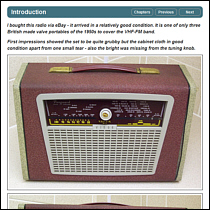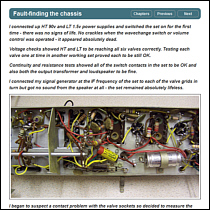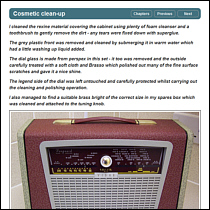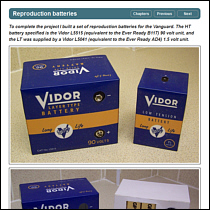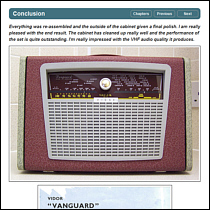
Vidor Vanguard CN436
-
1. Introduction
I bought this radio via eBay - it arrived in a relatively good condition. It is one of only three British made valve portables of the 1950s to cover the VHF-FM band. First impressions showed the set to be quite grubby but the cabinet cloth in good condition apart from one small tear - also the bright was missing from the tuning knob. Internally the chassis.....
-
2 Fault finding the chassis
I connected up HT 90v and LT 1.5v power supplies and switched the set on for the first time - there was no signs of life. No crackles when the wavechange switch or volume control was operated - it appeared absolutely dead. Voltage checks showed HT and LT to be reaching all six valves correctly. Testing each valve one at time in another.....
-
3. Cosmetic clean up
I cleaned the rexine material covering the cabinet using plenty of foam cleanser and a toothbrush to gently remove the dirt - any tears were fixed down with superglue. The grey plastic front was removed and cleaned by submerging it in warm water which had a little washing up liquid added. The dial glass is made from perspex in this set - it too was.....
-
4. Reproduction batteries
To complete the project I built a set of reproduction batteries for the Vanguard. The HT battery specified is the Vidor L5515 (equivalent to the Ever Ready B117) 90 volt unit, and the LT was supplied by a Vidor L5041 (equivalent to the Ever Ready AD4) 1.5 volt unit.
-
5. Conclusion
Everything was re-assembled and the outside of the cabinet given a final polish. I am really pleased with the end result. The cabinet has cleaned up really well and the performance of the set is quite outstanding. I'm really impressed with the VHF audio quality it produces.
Copyright © Robert Darwent · All rights reserved · E&OE · www.wavesintheair.co.uk online since 2015
